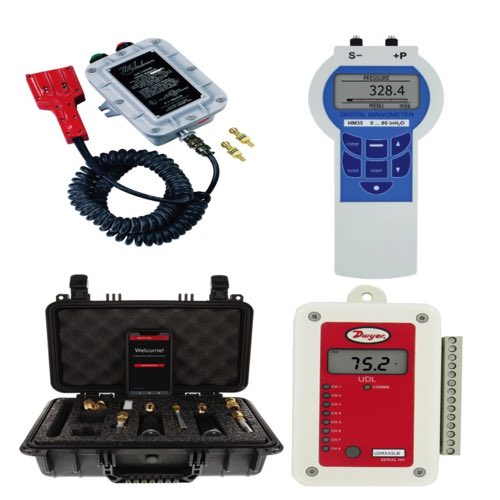Dwyer Test Equipment

Test equipment from Dwyer is meant to yield precise measurements and dependable results in a number of different industrial and commercial systems. It sits in controls rooms, issuing commands to other equipment so that those other pieces of equipment do what they need to do to keep any number of systems or processes working. And if anything goes wrong, Dwyer's test equipment will notice with plenty of time to let the people in control do whatever it is they need to do to keep the system or process running.
Dwyer portable test equipment are designed not only for precision performance but for dependable operation in the real world. They are used for anything from ground-level diagnostics to "fine-tuning in tough spots." They're built tough while still being easy to use and install. And with a range of products that just about covers every base, Dwyer can provide most any professional with the perfect testing instruments to enhance their operations—from HVAC balancing to process control.
More Information about Dwyer Test Equipment
One particularly remarkable aspect of Dwyer instruments is its focus on innovation, which has led to the integration of wireless capabilities and advanced software into many of its products. This has resulted in a nearly seamless user experience where data can be collected, analyzed (often in real time), and shared across many platforms. This level of performance allows for some really efficient, really accurate, and really fast tasks performed in the field, like "balancing the HVAC system" or "troubleshooting another complex industrial system." By providing so many robust and portable solutions, Dwyer makes it easy to work inside and outside of the field to monitor, adjust, and balance complex industrial systems on site.
FAQs
What category of Dwyer test instruments covers air velocity and temperature?
The category of Dwyer test instruments that covers air velocity and temperature includes anemometers and thermal anemometers, which are designed for precise airflow and temperature measurement in HVAC and industrial applications.
Analog and Digital Control Signals: The Basics
Digital Signals
Digital signals are represented in either a true or false. There is no gray area with digital signals. An example of this might be a light switch. A light switch is either on or off. Another example of this might be a motor that is running or not running. Digital signals can be generated with both AC and DC circuits with varying voltages, currents and resistance. Some practical examples of using digital signals in an industrial environment might be if a pump is running or not running or a whether a valve is open or closed.
Analog Signals
Analog signals convey information in the form of a range. A light switch might be on or off as a digital signal, but a dimmer switch would be an analog signal. It can be on or off, but it can also be somewhere in between. A practical example of using analog signals in an industrial environment would be if there is a need to measure the level of a tank; whether it's full, empty or somewhere in between. Analog signals can take many different forms with some of the more common being a 4 to 20 milliamp signal or a 0 to 5 or 0 to 10 volt signal.
Communication
Communication in a device can either be sent or received. Whether that data is sent or received depends on the type of information. Is there a need to monitor the status of something? If so, an input needs to be received about that information. Is there a need to control something? If so, an output needs to be sent about what needs to occur. Receiving inputs and setting outputs are both things that can be accomplished by using both digital and analog signal types. Therefore, the signals are referred to as analog outputs (AO), analog inputs (AI), digital inputs (DI) or digital outputs (DO).

